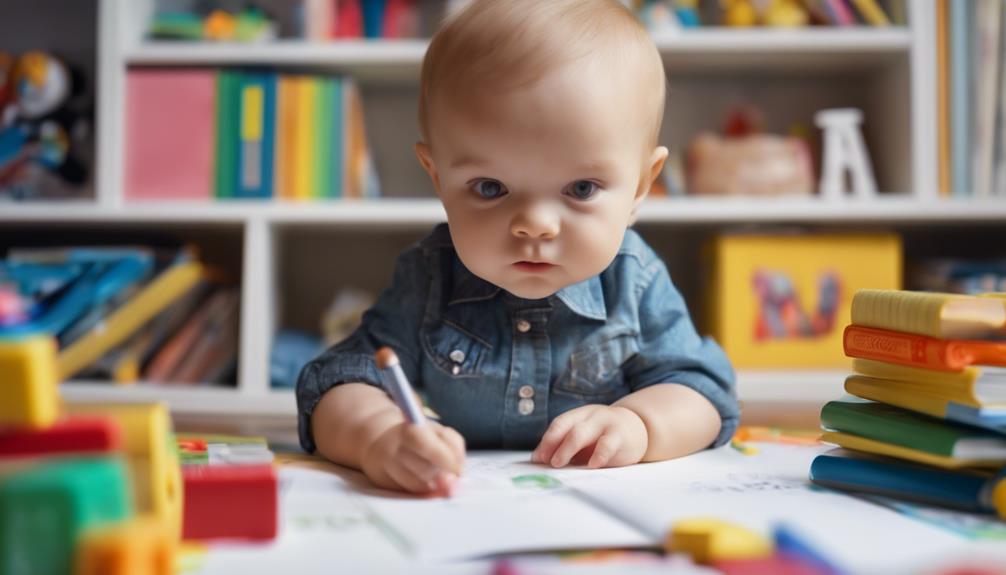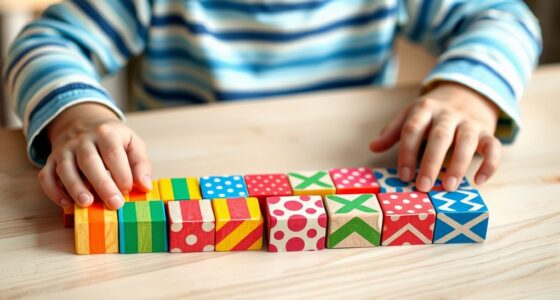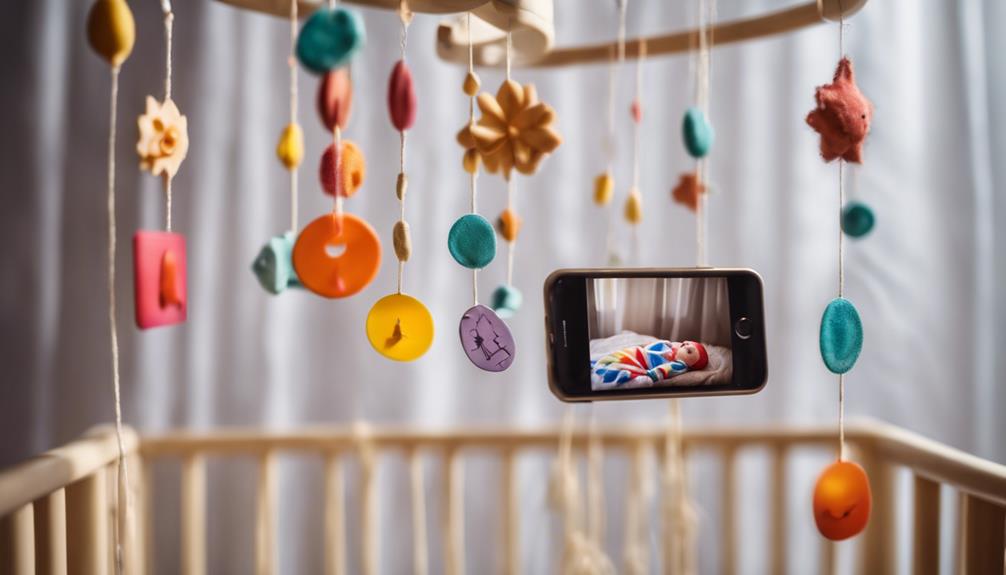To help promote early literacy in your infant, participate in interactive activities from the start to support language, cognitive, and motor skill development. Reading aloud helps with language and bonding, while interactive toys encourage learning. Encourage scribbling and point out words to help build early writing skills. Enhance fine motor skills by playing with crayons and blocks. Create a literacy-focused environment with books and storytelling. Engage in language interactions by describing daily activities. Instill a love for books by exploring a variety of genres and creating cozy reading nooks. These actions establish a solid foundation for your baby’s literacy journey, cultivating skills that are crucial for future learning.
Key Takeaways
- Read aloud daily to expose babies to language.
- Use interactive toys for sensory and cognitive development.
- Encourage word and letter recognition in everyday activities.
- Engage in fine motor skill activities for writing preparation.
- Create a literacy-rich environment with books and labels.
Importance of Early Literacy
Understanding the importance of early literacy is essential for setting a strong foundation for your child's future academic success. Early literacy skills play a vital role in your child's cognitive development and school readiness. By encouraging early writing, you help your child grasp the connection between spoken and printed words, laying the groundwork for language comprehension.
Additionally, engaging in writing activities from a young age aids in developing fine motor skills, which are fundamental for holding pencils and writing fluently later on. Early literacy not only promotes language development and communication skills but also instills a love for reading and writing in your child.
Reading Aloud Benefits

Reading aloud to babies is essential for their development, as it enhances vocal interaction between caregivers and infants. This early practice not only fosters cognitive growth but also aids in language acquisition.
Vocal Interaction Importance
Regularly engaging in vocal interaction while reading aloud to babies provides essential benefits for their early literacy development and language skills. When you read to your baby with enthusiasm and interact through voice modulation, you help them grasp the nuances of language. This vocal engagement exposes them to different tones, pitches, and emotions, aiding in their understanding of communication. Additionally, by incorporating interactive elements like asking questions or encouraging responses, you stimulate their cognitive abilities and foster a love for learning.
To emphasize the importance of vocal interaction during reading sessions, consider the following:
| Benefits of Vocal Interaction |
|---|
| Enhances language development |
| Builds listening skills |
| Strengthens parent-child bond |
Cognitive Development Benefits
Engaging in reading aloud to babies actively stimulates their cognitive development and nurtures essential language skills. By immersing infants in the world of storytelling, you're laying a strong foundation for their intellectual growth.
Regular reading sessions not only enhance brain activity but also aid in the development of vital listening skills, memory retention, and emotional intelligence. Babies who are read to regularly tend to have larger vocabularies and are more likely to excel academically in the future.
Furthermore, reading aloud creates a special bond between parents and babies, fostering a nurturing environment that's conducive to learning. This shared experience promotes not only cognitive development but also emotional well-being.
Additionally, the benefits of reading aloud extend beyond cognitive development, as it instills a love for books and storytelling in children, setting them on a path to becoming lifelong readers.
Interactive Toys for Learning

Interactive toys, such as alphabet blocks and electronic learning pads, play a pivotal role in aiding babies' early literacy development by engaging them in learning activities. These toys are designed to help babies learn letters and sounds through interactive play. Toys that respond to touch or movement can captivate babies' attention and make learning fun.
Additionally, interactive toys with music and lights can stimulate sensory development in babies, enhancing their overall learning experience. By providing toys that encourage exploration and discovery, parents can promote cognitive development in their babies, laying a strong foundation for future learning.
When choosing interactive toys for your baby, consider selecting age-appropriate options that align with their developmental stage. These toys can support your baby's early literacy skills in an engaging and interactive way.
Scribbling and Drawing Activities
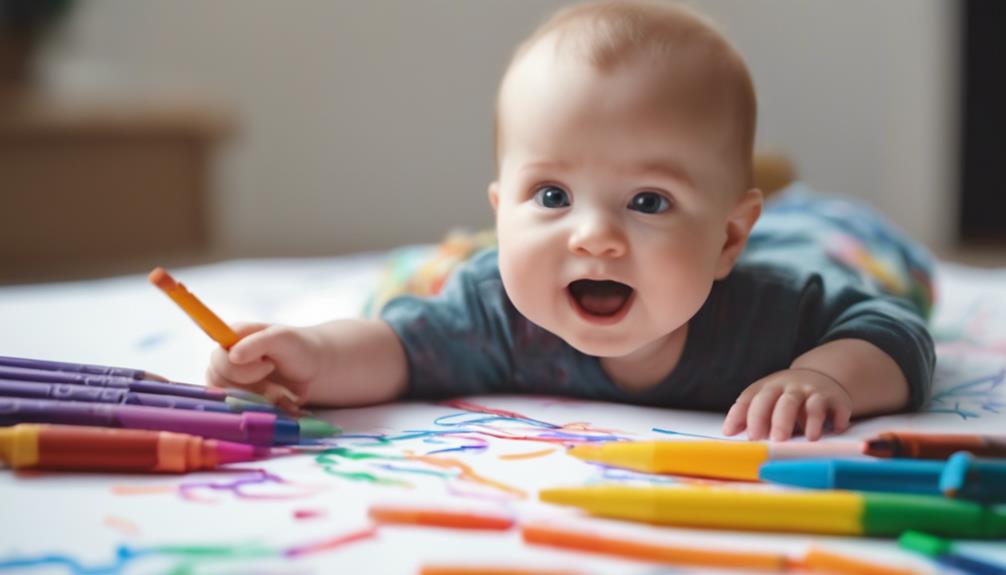
When encouraging early literacy through scribbling and drawing activities, it's crucial to provide your child with chunky, washable tools for colorful scribbling fun.
Engaging in social interactions about their creations can help develop their imagination and fine motor skills, as they learn to make basic shapes like circles, lines, and 'v's.
Colorful Scribbling Fun
Provide your child with washable, chunky tools to enhance their fine motor skills and hand-eye coordination through colorful scribbling activities. Engaging in these activities can be both fun and beneficial for your child's development.
Here are three key tips to make the most out of colorful scribbling sessions:
- Encourage Exploration: Allow your child to experiment with different colors and textures while scribbling. This exploration can stimulate their creativity and imagination, laying the foundation for future writing skills.
- Social Interaction: Take the time to talk to your child about their scribbles. By discussing their artwork, you not only foster their writing skills but also promote social interactions, which are essential for language development.
- Positive Reinforcement: Regardless of the outcome, always respond positively to your child's intent behind the scribbles. This encouragement helps build their confidence and motivates them to continue exploring their writing abilities.
Shapes and Lines
Engage your child in scribbling and drawing activities to develop their early writing skills through exploring basic shapes and lines. Encouraging these activities with washable, chunky tools helps in honing fine motor skills essential for writing.
By providing opportunities for your child to draw basic shapes like circles, lines, and 'v', you can effectively build their early writing abilities. Moreover, engaging in social interactions by discussing your child's creations not only fosters creativity but also promotes the development of writing skills.
Around the age of two, most children can create basic shapes, progressing to attempting letters or simple figures by age three. It's important to use chunky crayons, markers, and other tools to assist children in strengthening their hand muscles for better control and precision in their writing endeavors.
Imaginative Drawing Play
Encourage your child's creativity and early writing skills by incorporating imaginative drawing play through fun scribbling and drawing activities using washable, chunky tools. Engaging in these activities can help your child develop their fine motor skills and foster a love for writing from a young age.
Encourage Social Writing Interactions: Interacting with your child during drawing sessions can enhance their creativity and early literacy skills.
Respond Positively to Intent: Acknowledge and praise your child's efforts in their drawings, even if the final result isn't clear to you.
Promote Basic Writing Skills: Children as young as two years old can start creating basic shapes like 'v', circles, and lines through drawing, laying the foundation for future writing endeavors.
Pointing Out Words and Letters
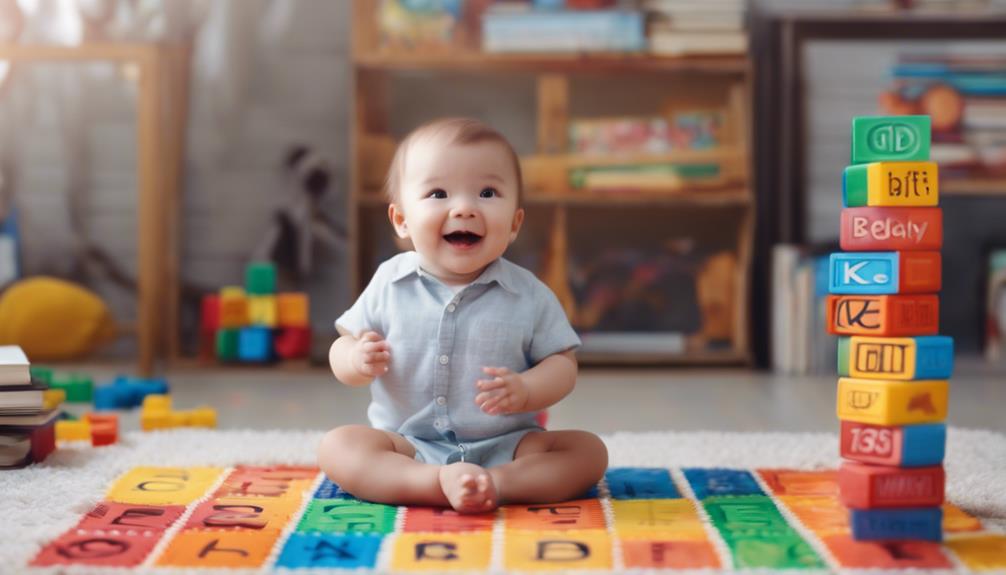
Start by incorporating words and letters into your daily interactions with your baby, pointing them out in various objects and surroundings to initiate early literacy skills.
By actively engaging with alphabet books and toys, you can introduce your baby to different letters and words, helping them recognize written language. Encourage your little one to point to and identify letters and words in books and around the house, making it a fun and interactive learning experience.
Additionally, pointing out environmental print such as signs, labels, and packaging can familiarize your baby with written language in real-world contexts. Transforming letter and word recognition into a playful game during daily activities can further enhance their understanding and retention of these important literacy skills.
Storytelling in Daily Routine
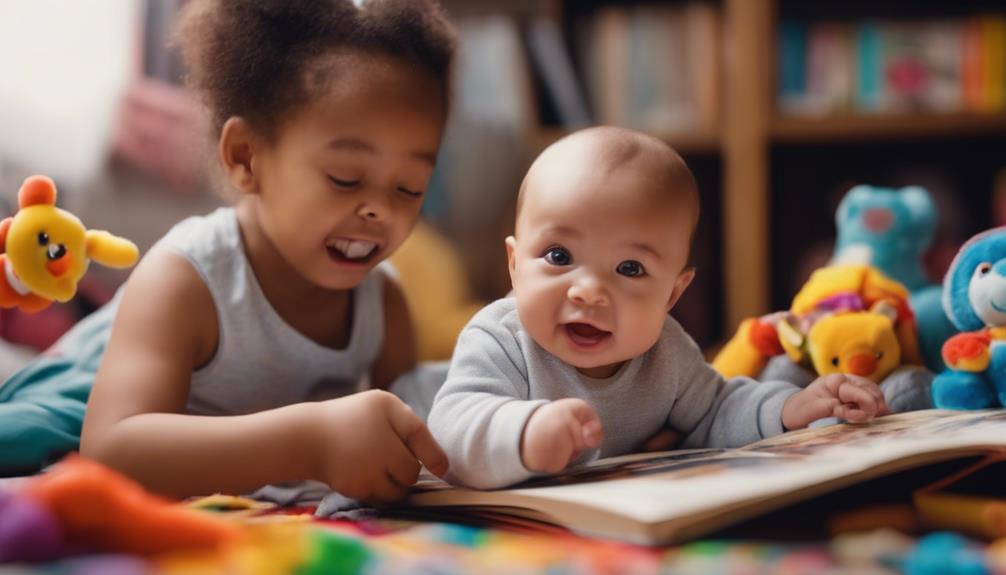
Incorporating storytelling into your daily routine can greatly enhance your baby's language development. Whether it's during bedtime, family gatherings, or meal times, sharing stories can create valuable narrative experiences for your little one.
Daily Bedtime Stories
Incorporate storytelling into your nightly routine to enhance early literacy skills in your baby. Bedtime stories offer more than just a cozy way to end the day; they play an important role in your baby's language development and cognitive growth.
Here's how bedtime stories can benefit your little one:
- Language Development: Reading to your baby before bedtime exposes them to a variety of words and sentence structures, helping expand their vocabulary and language skills.
- Listening Skills: Bedtime stories encourage babies to focus, listen, and follow along with the narrative, enhancing their ability to concentrate and comprehend spoken language.
- Routines and Comfort: Establishing a bedtime story routine can create a sense of security and comfort for your baby, signaling that it's time to wind down and prepare for sleep.
Family Story-Sharing Time
Enhance your family's daily routines by infusing them with the magic of storytelling, creating lasting memories and strengthening bonds through shared narratives.
Family story-sharing time is a wonderful way to engage your child's imagination and language skills while fostering a love for storytelling. By incorporating storytelling into everyday activities such as mealtime or before bedtime, you can make it a regular and enjoyable family tradition.
During family story-sharing time, encourage your child to participate by sharing personal stories or creating imaginative tales. Ask open-ended questions to spark their creativity and actively listen to their responses. To make the experience more interactive, consider using props, puppets, or storybooks to enhance the storytelling session.
Not only does family story-sharing time strengthen bonds between family members, but it also helps boost communication skills in children. By engaging in these shared narratives, you're creating a supportive environment that nurtures your child's love for storytelling and fosters a strong sense of connection within the family.
Storytelling During Meals
During meals, engage your baby in storytelling by sharing short stories or anecdotes to make storytelling a regular part of your daily routine. Mealtime storytelling can be a fun and educational way to bond with your baby while also promoting early literacy skills.
Here are some tips to make the most out of storytelling during meals:
- Engage your baby: Encourage active listening and participation by using expressive voices and gestures while telling stories.
- Introduce new words: Take advantage of mealtime to introduce your baby to new vocabulary and concepts through storytelling, helping expand their language skills.
- Encourage interaction: Prompt your baby to respond to the stories you share by asking questions or leaving pauses for them to react, fostering communication skills.
Developing Fine Motor Skills
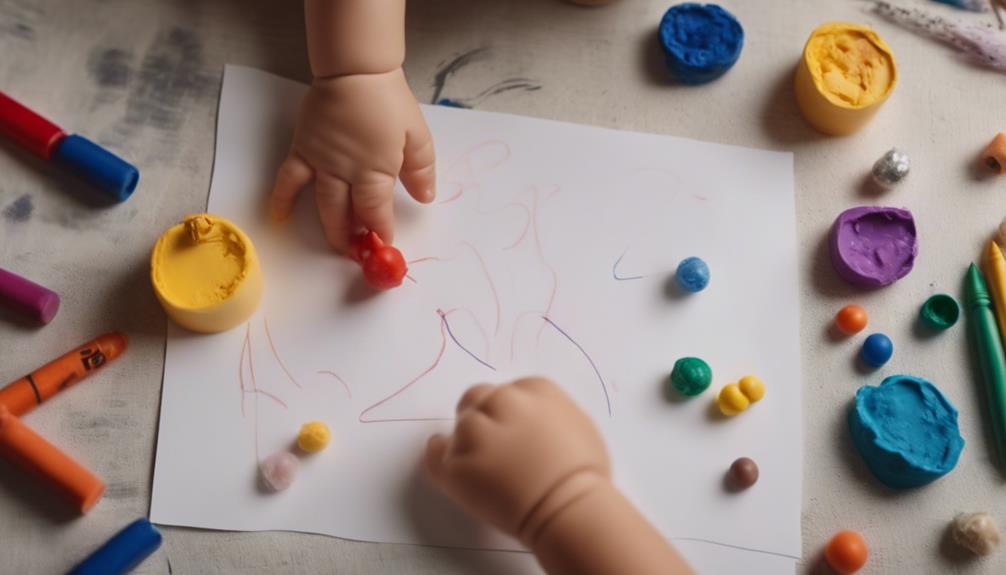
To help your child develop fine motor skills essential for writing, engage them in activities that strengthen their fingers and hands. Using chunky crayons, markers, scissors, and paintbrushes can enhance these skills.
Additionally, incorporating Duplo® blocks, playdough, and squeeze balls into playtime can help in developing the fine motor skills needed for writing.
Tearing paper is another simple yet effective activity that can strengthen the small hand muscles vital for writing tasks. By offering a variety of activities that focus on finger and hand movements, you can aid in preparing your child for holding and controlling writing tools.
Creating a Literacy-Rich Environment

Create a nurturing environment for your baby by surrounding them with books, writing materials, and literacy-focused toys to foster early literacy skills. To make your home a literacy-rich environment, consider the following:
- Displaying Writing and Drawings:
Showcase your child's creations prominently to boost their confidence and pride in their work. This encourages them to engage more with writing and drawing activities.
- Engaging in Storytelling:
Storytelling activities not only enhance language development but also stimulate your child's imagination and creativity. Encourage interactive storytelling sessions to make learning fun and engaging.
- Labeling Everyday Objects:
Labeling items around the house, like during grocery shopping, helps your child associate written words with their meanings. This simple practice can aid in building their vocabulary and understanding of language.
Engaging Language and Communication
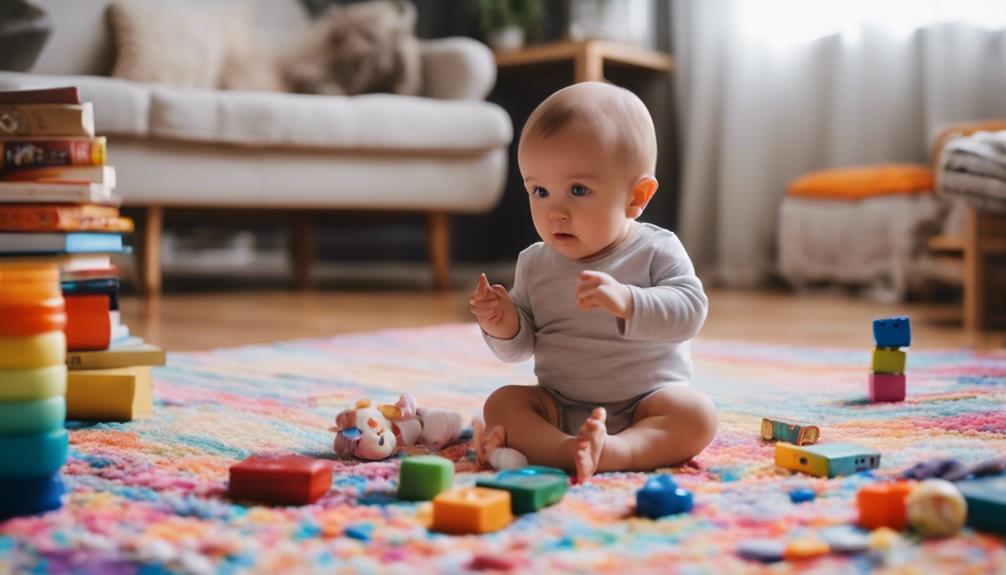
Enhance your baby's early literacy skills by actively engaging in language and communication interactions throughout your daily routines. Talking to your baby not only introduces them to new words and sounds but also boosts their language development.
Encourage your baby's chatters and babbles by listening and responding attentively; this practice helps them hone their communication skills. Describe your surroundings and the activities you're doing to expose your baby to new vocabulary and help them understand the world around them.
Additionally, pointing to and labeling objects for your baby aids in connecting words to their corresponding objects and concepts, facilitating language learning.
To further enrich your baby's language skills, make up stories as you go about your day. Narrating simple tales not only captivates your baby's attention but also exposes them to different sentence structures and vocabulary. Remember, babies babble using sounds they've heard, so engaging in these language-rich interactions is vital for their language development.
Fostering Love for Reading and Writing
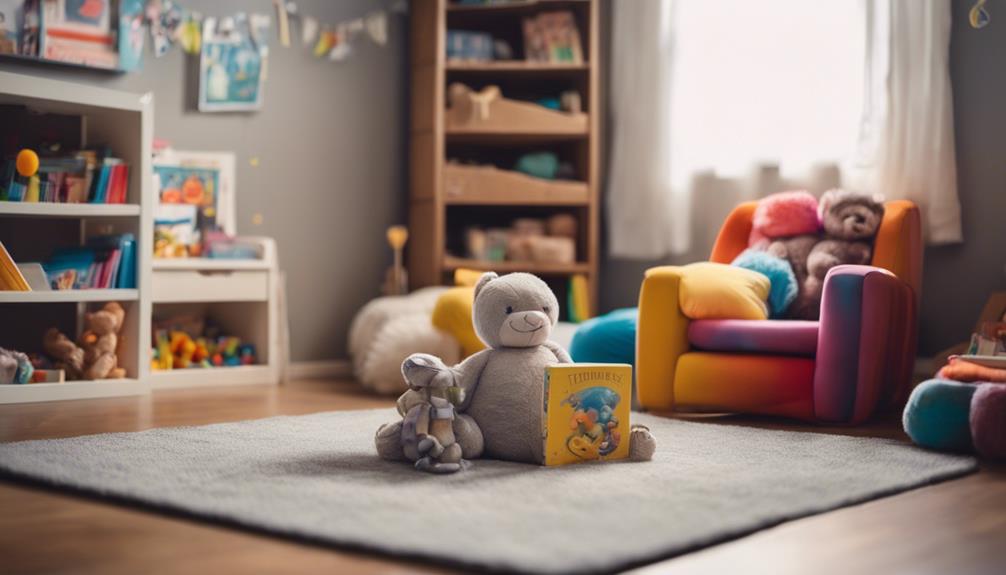
Engage in daily reading sessions with your baby to nurture a love for books and storytelling. Reading together not only creates a special bonding time but also sets the stage for a lifelong appreciation of literature. By actively involving your baby in these sessions, you can begin to recognize their growing interest in words and narratives.
Here are three essential tips to foster a love for reading and writing in your little one:
- Make it interactive: Encourage your baby to point at pictures, turn pages, or even babble along with the story. This interaction helps them connect words to meaning and fuels their curiosity.
- Explore various genres: Introduce a range of books including fiction, non-fiction, rhymes, and more. This exposure broadens their literary horizons and helps them discover their preferences.
- Create a cozy reading nook: Design a comfortable space with pillows, blankets, and a selection of books within easy reach. This cozy environment can make reading time a cherished daily ritual for both of you.
Frequently Asked Questions
How Can We Encourage Babies to Learn Literacy?
To help babies learn literacy, chat with them often, sing tunes for new words, and enjoy reading together. Let them scribble and create messily. Show writing habits and offer various tools for baby literacy growth.
How Can Early Literacy Be Encouraged?
You can encourage early literacy by engaging in activities like storytelling, discussing children's writing, and incorporating writing into daily routines. Encourage children to describe their creations, expanding vocabulary and promoting language skills.
At What Age Should a Baby Start Writing?
Around 12-18 months, your little one might start scribbling, hinting at future writing adventures. By age two, they may craft basic shapes. At three, they might attempt letters. Nurture this creativity for early literacy success.
Does Early Literacy Include Writing?
Yes, early literacy includes writing. Writing helps children connect spoken and printed words, understand the purpose of reading, and enhance fine motor skills. Through writing activities, kids learn that letters represent words, fostering communication skills.
Conclusion
To sum up, fostering early literacy in babies is vital for their cognitive development. Just like planting seeds in a garden, nurturing a love for reading and writing at a young age sets the foundation for a fruitful future.
By engaging in interactive activities, creating a literacy-rich environment, and encouraging language and communication, you're providing your little one with the tools they need to flourish.
So, grab a book, a toy, or a crayon, and watch their literacy skills bloom!

